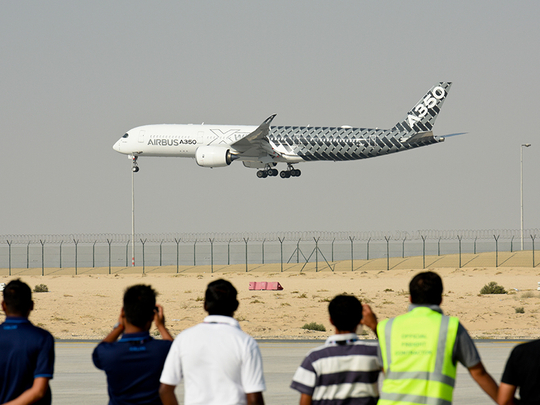
Dubai: The Middle East will need 2,460 new aircraft worth $590 billion (Dh2.17 trillion) over the next 20 years, European plane maker Airbus said on Monday, 720 less than what rival Boeing estimates.
Airbus says strong growth over the next 20 years, driven by the regions big three carriers Emirates, Etihad Airways and Qatar Airways, will see 1,800 aircraft needed to match growth and 600 for replacements.
But Airbus is also seeing opportunities outside the big three, who are rapidly expanding, with expectations for sales in Saudi Arabia, Egypt and Libya.
“Egypt is going through a rough period with tourism down but aviation will be a big part of their growth going forward,” John Leahy, Airbus’ Chief Operating Officer for customer sales, told reporters at the Dubai Airshow on Monday when he announced Airbus’ Global Market Forecast 2015 – 2034.
Sustained low oil prices, which have lost more than half their value since mid-2014, are also expected to spur near-term orders as airlines profits increase. Fuel is generally an airline’s single largest operating cost.
“In this industry when airlines have extra cash and extra profits they tend to be inclined to purchase new aircraft,” Leahy said.
Unlike elsewhere in the world where single aisle aircraft sales dominate, Airbus says the Middle East will mainly need twin aisle and very large aircraft over the next 20 years. It estimates the region will need 890 single aisle aircraft, like the Airbus A320 and Boeing 737, 1,150 twin-aisle aircraft like the Boeing 787 and Airbus A350 and 420 very large aircraft like the Airbus A380.
Globally, Airbus sees 32,590 aircraft to be delivered between now and 2034. This is slightly more than its 2014–2033 forecast when it said 31,358 would be needed. Of the 32,590 aircraft to be delivered in the next twenty years, Airbus sees 22,930 single aisle aircraft, 8,110 twin aisle aircraft and 1,550 very large aircraft. In comparison, US manufacturer Boeing expects there will be demand for 38,050 aircraft over the same period with 3,180 to head to Middle East carriers.
Airbus said global demand will come out of developing markets with an emerging middle class. It believes demand in India will grow from 1 in 15 people flying each year today to 1 in 3 by 2034. In China it sees this increasing from 1 in 3 flying each year to just over 1.












